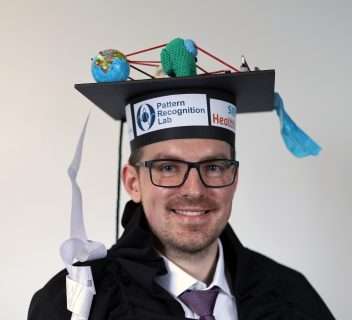Felix Meister
Deep Learning and Computational Modeling of Physiology
Deep Learning (DL) and computational modeling (CM) could revolutionize the healthcare system by personalizing therapies to patients and enabling precision medicine (PM). While DL can automatically extract decision rules from large amounts of data, CM leverages known principles from physics and physiology to provide mechanistic insights into biophysical phenomena. However, both methods may fail in scenarios that lack data and precise mathematical formulations of the governing laws. With a particular focus on physiology modeling, this thesis investigates how these methods can enhance each other. First, a novel approach to extrapolate the sparse measurements of electroanatomic mapping (EAM) is presented. A graph neural network (GNN) is trained on geometric and electrophysiological features derived from over 15,000 synthetic depolarization patterns. Without re-training, the GNN is applied to synthetic and pre-clinical measurements. With a mean absolute error of less than 10 ms in all experiments, a good agreement with the reference measurements is achieved. In addition, a network-ensemble-based algorithm for the guidance of the sampling process is presented. The system achieves real-time suggestions of valuable locations while reducing the number of measurement points, required to maintain the same predictive error compared to randomized sampling, by 40%. Second, a hybrid system for fast biomechanical simulations of soft tissue is presented, which couples the Finite Element Method (FEM) with an artificial neural network (ANN). Specifically, the explicit time integration in the Total Lagrangian Explicit Dynamics (TLED) algorithm, an efficient FEM implementation, is replaced by the ANN. Given the current system state, the ANN infers vertex-wise accelerations that move each vertex for a time step much larger than TLED’s stability limit. A multilayer perceptron (MLP) is trained on a single simulation, i.e., the torsion of a bar, and demonstrates excellent generalization when applied to unseen geometries, motions, and material behaviors, which is attributed to the inductive biases imposed by the underlying FEM solver. Finally, an operator-learning-based surrogate model for fast liver tumor radiofrequency ablation (RFA) planning is presented. Specifically, a convolutional neural network (CNN) learns the solution operator to the underlying advection-diffusion-reaction system, which maps the voxelized initial and boundary conditions to the temperature distribution at some point in time. The proposed CNN is trained and evaluated in a leave-one-out cross-validation using RFA simulations generated by the Finite Difference Method (FDM). The CNN infers ablation zones that match the FDM reference with a dice score of 0.93 ± 0.05. Moreover, the inference is over 100 times faster than the FDM due to the parallel and non-autoregressive inference. In addition, the method is applied to automatic patient-specific planning of single needle RFA. Compared to FDM-based planning, the method achieves similar needle positioning while being marginally slower than sphere-based planning. The promising results achieved by the proposed approaches confirm the benefits of combining CM and DL. Future research will focus on integrating additional inductive biases for even better accuracy and generalization. In addition, the application to other biophysical processes will be explored. Ultimately, their application can be used for fast and accurate full in-silico representations of patients that hold the potential to revolutionize the healthcare system via PM.
